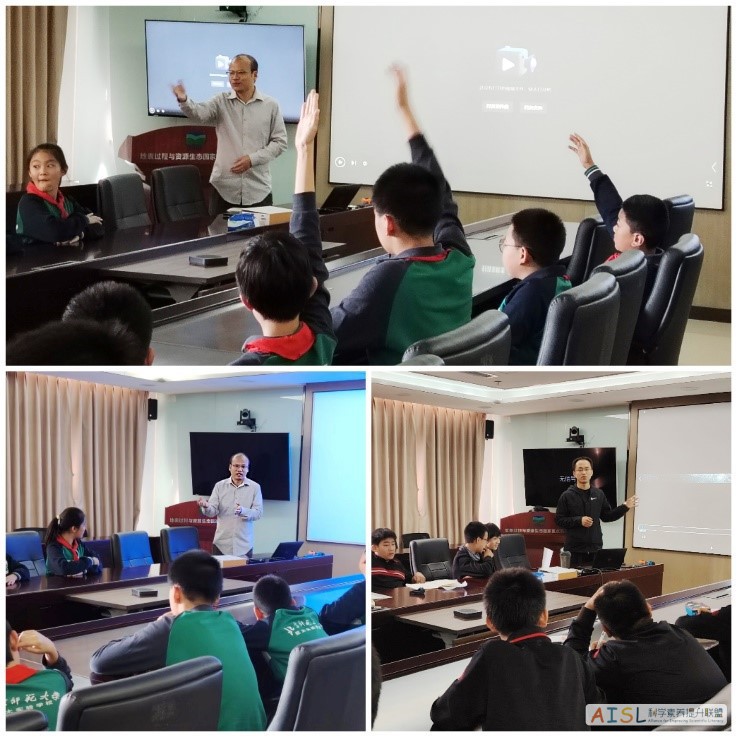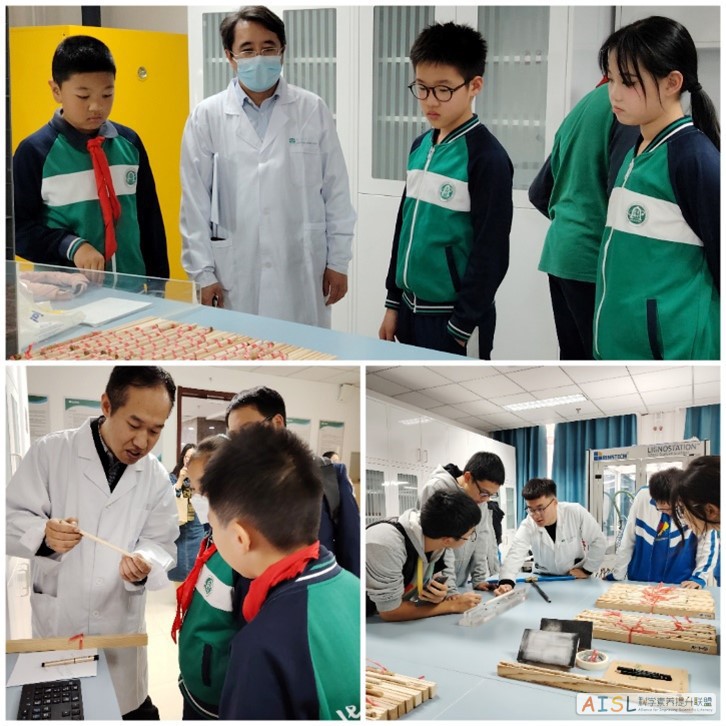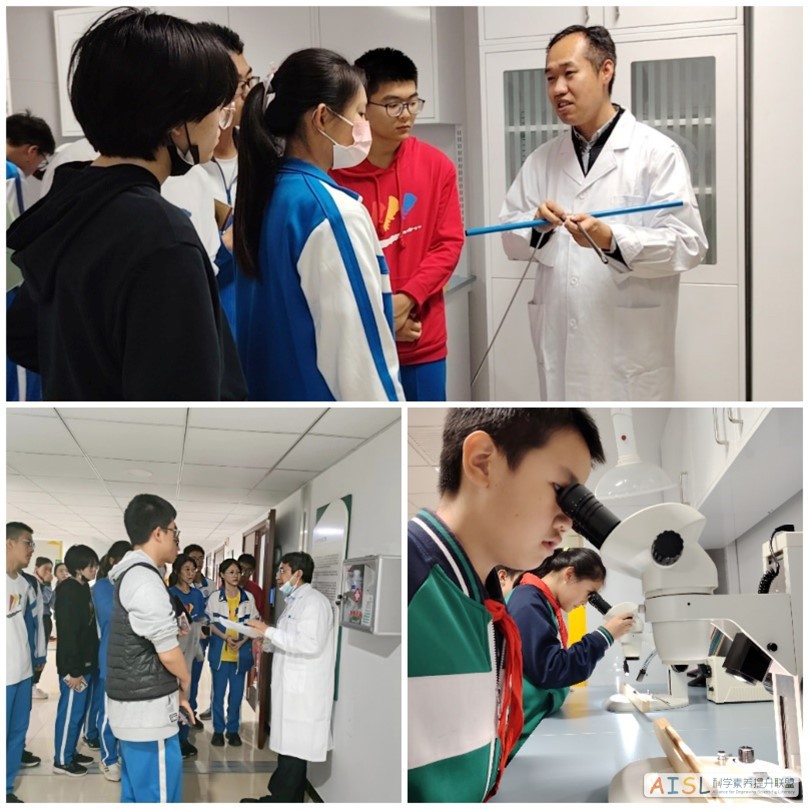为贯彻落实科教兴国战略、人才强国战略、创新驱动发展战略,大力弘扬科学精神和科学家精神,将科学家精神从抽象符号转化为生动的科学家故事,引导中小学生走近科学家,感受科学魅力,体悟科学家精神,增强科学探索的兴趣,2023年10月27日,在北京师范大学地表过程与资源生态国家重点实验室的大力支持下,北京师范大学“社会性科学议题学习(SSI-L)”项目办组织三所北京师范大学基础教育学校——北京师范大学附属实验中学、北京师范大学亚太实验学校、北京师范大学第二附属中学,参与“SSI-L”项目的小学生、初中生、高中生共计132位,参观北京师范大学地表过程与资源生态国家重点实验室。

此次参观共有3个环节:实验室整体介绍、分析测试平台和树轮实验室参观、黑河地表综合观测系统和冰芯研究介绍。实验室多位科研人员针对“社会性科学议题学习”项目《全球变暖》课程内容及中小学生认知特点,精心设计讲解内容,为中小学生开展了一场深入浅出的科普教育。

实验室整体介绍环节,张通老师与胡广荣老师介绍了实验室的基本情况、研究方向及部分研究成果,随后学生从生态系统保护、气候变化影响、科考技术等方面提出了诸多有趣的问题,通过深入交流,学生意识到了气候变化研究是关乎整个地球系统安全和人类命运的重大科学问题。呵护我们的地球,实现“碳达峰”、“碳中和”,是实现人类与地球可持续发展的必经之路。

分析测试平台和树轮实验室参观环节,高晓飞老师带领同学们参观了实验室室内分析测试平台,包括释光测年实验室、稳定同位素质谱实验室、高纯锗γ能谱仪室、ICP光谱仪室、粒度分析仪室、土壤物理实验室、X射线荧光仪室和灾害风险协同监测室等,对各分析平台的作用与原理进行了详细的解说。在树轮实验室,段建平老师详细介绍了树木年轮与气候变化之间的关系,以及如何通过树木年轮探索几十年、几百年乃至几千年前的气候变化,学生通过显微镜观察了从祁连山采取的树轮样本,段老师还对学生提出的问题进行了详细解答。

黑河地表综合观测系统和冰芯研究介绍环节。徐自为老师详细介绍并展示了实验室搭建的黑河流域地表多要素实时监测系统,从数据采集、传输、汇总和汇交以及野外观测场实时监控,同学们都惊叹监测系统的先进及建设监测系统的不易。苏勃老师给同学们做了题为“冰芯记录的气候变化”的科普报告,深度解读了冰芯的环境记录信息、结构特点、野外采样、和室内分析及如何利用冰芯探究万年前的气温和二氧化碳变化。苏老师结合法国冰川学家克劳德·洛里乌斯的在南极考察时意外发现冰芯气泡的事迹,启发学生科学就在身边,要善于观察和思考,并结合“巴黎协议”温控目标和我国“双碳”目标,渗透了全球变暖中的个体责任意识。

通过国重实验室的实地参观与科学家面对面的交流,同学们解开了气候变化的科学之谜,认识到气候变暖对人类社会的严重危害及减少温室气体排放的迫切性,也感受到了科学家追求真理,不畏艰险,勇攀高峰的精神。参观现场热烈,同学们兴趣盎然,意犹未尽,直至结束同学们还有很多疑惑想与科学家们交流,还期待着下次见面。中小学生热爱科学的种子悄悄种下!
It aims to implement better strategies for rejuvenating the country through science and education, strengthening the country through talents, and innovation-driven development; it also aims to vigorously promote the spirit of science and the spirit of scientists, translate the spirit of scientists from abstract symbols into vivid stories of scientists, and guide primary and secondary school students to get closer to scientists, feel the charm of science, and understand scientists spirit and enhance their interest in scientific exploration; on October 27, 2023, with the strong support of BNU’s State Key Laboratory of Earth Surface Processes and Resource Ecology, the Socio-Scientific Issues Learning (SSI-L) project office of BNU organized a total of 132 primary, junior high, and high school students who have participated in the SSI-L project, from three basic education schools of BNU — the Experimental Middle School Affiliated to BNU, the Asia-Pacific Experimental School of BNU, and the Second High School Attached to BNU, to visit the State Key Laboratory of Earth Surface Processes and Resource Ecology.
The visit consisted of three sessions: an overall lab introduction, a visit to the analysis test platform and tree-ring laboratory, and an introduction to the Heihe surface comprehensive observation system and ice core research. In accordance with the SSI-L curriculum content of “Global Warming” and the cognitive characteristics of primary and secondary school students, a number of science researchers in the laboratory carefully designed their presentation content, and carried out an easy-to-understand and vivid science education for students.
During the session on the overall lab introduction, Zhang Tong and Hu Guangrong introduced the basic situation, research directions, and some research results of the laboratory. After that, students raised many interesting questions about aspects of ecosystem protection, climate change impact, scientific investigation technology, etc. Through face-to-face exchanges, students realized that climate change research is a major scientific issue critical to the security of the entire earth system and the destiny of mankind. The only way to achieve sustainable development of mankind and the earth is to take good care of our planet and realize “carbon peak” and “carbon neutrality”.
During the session on visiting the analysis testing platform and tree-ring laboratory, Gao Xiaofei led students to visit the laboratory’s indoor analysis and testing platform, including the luminescence dating laboratory, stable isotope mass spectrometry laboratory, high-purity germanium gamma spectrometer room, ICP spectrometer room, particle size analyzer room, soil physics laboratory, X-ray fluorescence room, and disaster risk collaborative monitoring room. The function and principle of each analysis platform were explained in detail. In the tree-ring laboratory, Duan Jianping introduced in detail the relationship between tree rings and climate change, and how to use tree rings to investigate climate changes that happened decades, centuries or even thousands of years ago. Students observed tree ring samples taken from the Qilian Mountains through microscopes. Duan also gave detailed answers to questions raised by students.
During the session on the Heihe surface comprehensive observation system and ice core research, Xu Ziwei introduced and demonstrated in detail the multi-element real-time monitoring system for the surface of the Heihe River Basin built in the laboratory. From data collection, transmission, summary, and convergence to real-time monitoring of field observation sites, the students were amazed at the advanced monitoring system and the difficulties in constructing the monitoring system. Su Bo presented a science popularization report to the students titled “Climate Change Recorded by Ice Cores”. He gave an in-depth explanation of the environmental record information, structural characteristics, field sampling, and indoor analysis of ice cores, and how to use ice cores to explore the changes in temperature and carbon dioxide tens of thousands of years ago. Su combined the story of French glaciologist Claude Laurieus who accidentally discovered bubbles in ice cores during an Antarctic expedition to inspire students that science is around them and they must be good at observation and thinking. He also permeated the awareness of individual responsibility in global warming, in combination with the temperature control goals of the Paris Agreement and China’s “double carbon” goals.
Through on-site visits to the State Key Laboratory and face-to-face communication with scientists, students solved the scientific mystery of climate change, and realized the serious harm of climate warming to human society and the urgency of reducing greenhouse gas emissions. They also felt scientists’ spirit of pursuing the truth, not being afraid of hardships and dangers, and bravely challenging new heights. The visit was lively and exciting. Students were full of interest and still had a lot to say. Until the end, they still had many questions to communicate with the scientists and were looking forward to the next visit. The seeds of love for science were quietly planted among these primary and middle school students!
